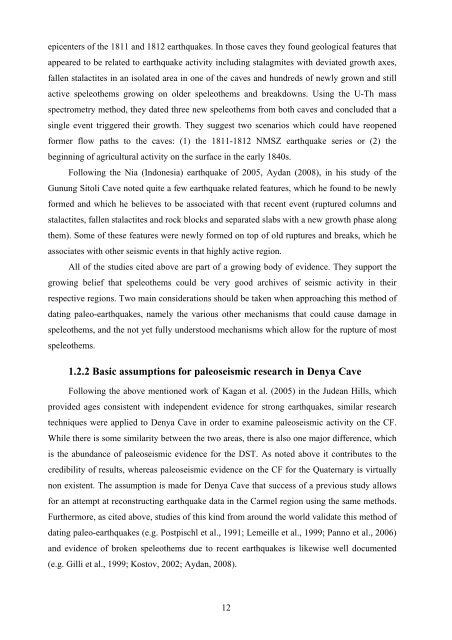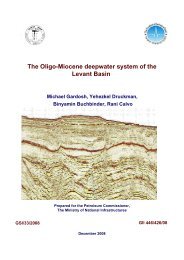tivity on the carmel faul
tivity on the carmel faul
tivity on the carmel faul
Create successful ePaper yourself
Turn your PDF publications into a flip-book with our unique Google optimized e-Paper software.
epicenters of <strong>the</strong> 1811 and 1812 earthquakes. In those caves <strong>the</strong>y found geological features that<br />
appeared to be related to earthquake ac<str<strong>on</strong>g>tivity</str<strong>on</strong>g> including stalagmites with deviated growth axes,<br />
fallen stalactites in an isolated area in <strong>on</strong>e of <strong>the</strong> caves and hundreds of newly grown and still<br />
active speleo<strong>the</strong>ms growing <strong>on</strong> older speleo<strong>the</strong>ms and breakdowns. Using <strong>the</strong> U-Th mass<br />
spectrometry method, <strong>the</strong>y dated three new speleo<strong>the</strong>ms from both caves and c<strong>on</strong>cluded that a<br />
single event triggered <strong>the</strong>ir growth. They suggest two scenarios which could have reopened<br />
former flow paths to <strong>the</strong> caves: (1) <strong>the</strong> 1811-1812 NMSZ earthquake series or (2) <strong>the</strong><br />
beginning of agricultural ac<str<strong>on</strong>g>tivity</str<strong>on</strong>g> <strong>on</strong> <strong>the</strong> surface in <strong>the</strong> early 1840s.<br />
Following <strong>the</strong> Nia (Ind<strong>on</strong>esia) earthquake of 2005, Aydan (2008), in his study of <strong>the</strong><br />
Gunung Sitoli Cave noted quite a few earthquake related features, which he found to be newly<br />
formed and which he believes to be associated with that recent event (ruptured columns and<br />
stalactites, fallen stalactites and rock blocks and separated slabs with a new growth phase al<strong>on</strong>g<br />
<strong>the</strong>m). Some of <strong>the</strong>se features were newly formed <strong>on</strong> top of old ruptures and breaks, which he<br />
associates with o<strong>the</strong>r seismic events in that highly active regi<strong>on</strong>.<br />
All of <strong>the</strong> studies cited above are part of a growing body of evidence. They support <strong>the</strong><br />
growing belief that speleo<strong>the</strong>ms could be very good archives of seismic ac<str<strong>on</strong>g>tivity</str<strong>on</strong>g> in <strong>the</strong>ir<br />
respective regi<strong>on</strong>s. Two main c<strong>on</strong>siderati<strong>on</strong>s should be taken when approaching this method of<br />
dating paleo-earthquakes, namely <strong>the</strong> various o<strong>the</strong>r mechanisms that could cause damage in<br />
speleo<strong>the</strong>ms, and <strong>the</strong> not yet fully understood mechanisms which allow for <strong>the</strong> rupture of most<br />
speleo<strong>the</strong>ms.<br />
1.2.2 Basic assumpti<strong>on</strong>s for paleoseismic research in Denya Cave<br />
Following <strong>the</strong> above menti<strong>on</strong>ed work of Kagan et al. (2005) in <strong>the</strong> Judean Hills, which<br />
provided ages c<strong>on</strong>sistent with independent evidence for str<strong>on</strong>g earthquakes, similar research<br />
techniques were applied to Denya Cave in order to examine paleoseismic ac<str<strong>on</strong>g>tivity</str<strong>on</strong>g> <strong>on</strong> <strong>the</strong> CF.<br />
While <strong>the</strong>re is some similarity between <strong>the</strong> two areas, <strong>the</strong>re is also <strong>on</strong>e major difference, which<br />
is <strong>the</strong> abundance of paleoseismic evidence for <strong>the</strong> DST. As noted above it c<strong>on</strong>tributes to <strong>the</strong><br />
credibility of results, whereas paleoseismic evidence <strong>on</strong> <strong>the</strong> CF for <strong>the</strong> Quaternary is virtually<br />
n<strong>on</strong> existent. The assumpti<strong>on</strong> is made for Denya Cave that success of a previous study allows<br />
for an attempt at rec<strong>on</strong>structing earthquake data in <strong>the</strong> Carmel regi<strong>on</strong> using <strong>the</strong> same methods.<br />
Fur<strong>the</strong>rmore, as cited above, studies of this kind from around <strong>the</strong> world validate this method of<br />
dating paleo-earthquakes (e.g. Postpischl et al., 1991; Lemeille et al., 1999; Panno et al., 2006)<br />
and evidence of broken speleo<strong>the</strong>ms due to recent earthquakes is likewise well documented<br />
(e.g. Gilli et al., 1999; Kostov, 2002; Aydan, 2008).<br />
12

















